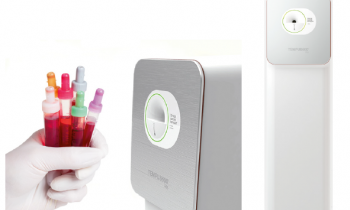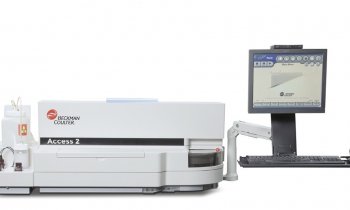Article • Breath analysis to aid diagnoses
Breathomics: far more than hot air
In diagnostics, it sometimes makes sense to follow your nose. During the Labmed Forum at Medica 2019, Dr Beniam Ghebremedhin and Dr Simona Cristescu discussed the diagnostic potential of breathomics – the analysis of a patient’s exhaled air for disease indicators.
Report: Wolfgang Behrends
Image source: Unsplash/Joanna Kosinska (Editing: HiE/Behrends)
The idea that a patient’s breath can aid in the diagnosis of diseases is far from new: In ancient Greece, physicians considered sweet smelling breath an indicator of diabetes or a fishy smell suggesting a liver condition. While modern breathomics is based on the same principle, it is much more sophisticated and offers a host of diagnostic insights.
Exhaled air consists mainly of nitrogen, oxygen, argon and water. In addition, there are traces of hundreds and even thousands of so-called volatile organic compounds (VOC) – and ‘traces’ here does mean minute amounts, measured in parts per million (ppm), or even parts per billion (ppb). Nevertheless, these VOCs reflect a person’s health status, in certain cases even long before other biomarkers indicate that something is off-kilter.
Prognostic potential

Photo: HiE/Behrends
‘Changes in the VOC profile of a person have enormous potential for the early diagnosis of diseases and can even be used for prognostic purposes,’ said Dr Beniam Ghebremedhin, microbiology expert at Helios University Hospital in Wuppertal, Germany. The major advantage: the method is non-invasive and is thus suited for neonates for whom drawing blood constitutes a risk.
Today, there are several methods to determine VOCs based on mass spectrometry. Gas-chromatography (GC-MS), eNose and infrared spectroscopy have their specific advantages and drawbacks and are suited for different diagnostic profiles. However, there are options beyond lab procedures: dogs can smell diabetes and even lung cancer in the patient’s exhaled air. Unfortunately, as the expert points out, ‘Dogs require long and complex training, which makes this option hardly suitable for mass application.’
Extensive preparation, few common denominators
The technical measurements are not straightforward either: the exhaled air samples must be prepared for the instruments to be able to detect VOCs. Several procedures are available, inter alia solid phase microextraction (SPME), thermal desorption or so-called needle-trap techniques, with each of these procedures coming with their own advantages and disadvantages. After the lengthy preparation and processing, the data are analysed to determine the pathology.
The numerous procedures cover a wide range of possible diseases. Paradoxically, this strength of breathomics is at the same time one of its weaknesses since, as Ghebremedhin explains, there is currently no standardised approach to allow comparison of results: ‘We don’t even have an agreed-upon terminology; for example, there is no hard and fast definition for the basic elements such as the different phases of the exhaled air.’
A volatile fingerprint offers a wealth of information

Simona Cristescu, expert member of the Exhaled Biomarkers Group at the Department of Molecular and Laser Physics at Radboud University in Nijmegen, Netherlands, stresses the benefits of a good nose: ‘Many diseases follow a specific metabolic schedule. Take a Pseudomonas aeroginosa infection, for example. In the course of the disease, hydrogen cyanide (HCN) and ammonia (NH3) are produced. Both are volatile compounds of exhaled breath and can be detected. However, the two compounds are not produced at the same time. Thus, if we notice a decrease in the HCN concentration in the exhaled air, and an increase in the NH3 concentration, we conclude that the infection has entered a new stage and we can adjust the treatment correspondingly.’
In brief: the chemical VOC fingerprint not only provides information on the kind of disease present but also on the disease progression. Even the interaction of several pathogens in a polymicrobial environment can be tracked in the exhaled air. For the experts, breathomics is an interesting diagnostic tool with promising approaches and significant potential. However, a number of obstacles have to be overcome before this potential can be fully leveraged in clinical routine.
Profiles:
PD Dr Beniam Ghebremedhin is a specialist in microbiology, virology and infection epidemiology, and a biochemist and specialist in laboratory medicine at Helios University Hospital in Wuppertal, Germany. He also teaches at the University Witten/Herdecke. His research focuses on molecular epidemiology of multi-resistant pathogens, particularly in the hospital, and the development/introduction of new tools for infection diagnostics. His memberships of professional societies include the German Society for Hygiene and Microbiology (DGHM); German Society for Clinical Chemistry and Laboratory Medicine (DGKL); European Society of Clinical Microbiology and Infectious Diseases (ESCMID), and the American Society of Microbiology (ASM).
Dr Simona Cristescu is Assistant Professor at Radboud University Nijmegen, Netherlands. As a member of the Exhaled Biomarkers Group she studies the composition of organic compounds in breathing air and their significance with regard to diagnostics and treatment monitoring. She is a member of several professional societies, inter alia, European Respiratory Society (ERS) and the International Association of Breath Research (IABR).
06.04.2020











